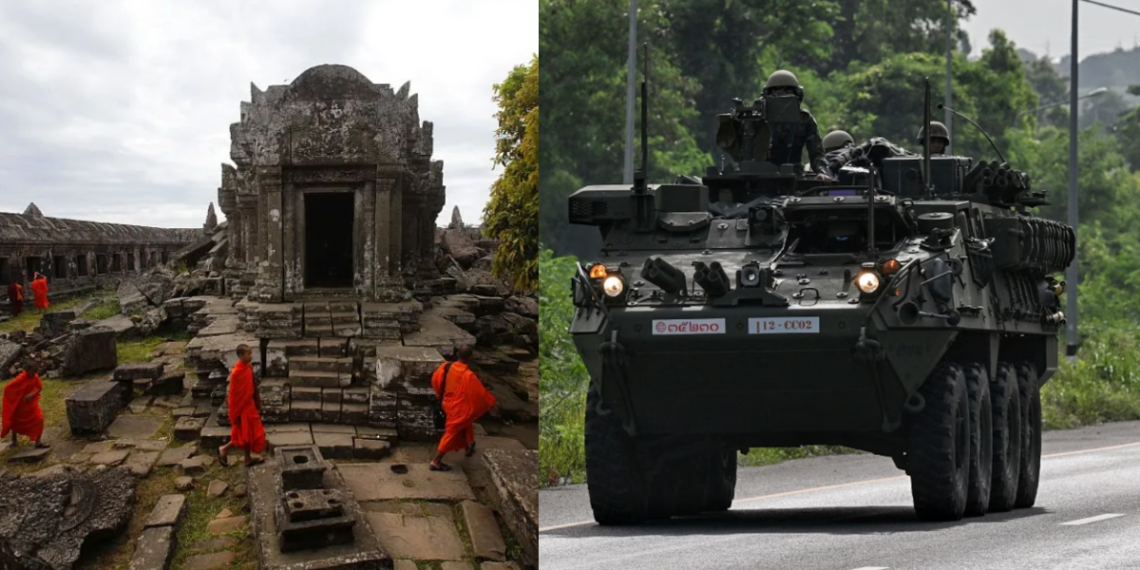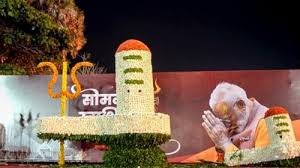New Delhi:
Tensions along the Thailand-Cambodia border have escalated once again over a centuries-old dispute involving ancient Hindu temples, with the latest round of violence resulting in 12 deaths, dozens injured, and the evacuation of tens of thousands of civilians.
A sacred temple on the edge:
At the center of the dispute lies the Preah Vihear temple, a 900-year-old Hindu shrine dedicated to Lord Shiva. Perched dramatically on a 525-metre-high cliff in Cambodia’s Dangrek Mountains, the temple is a masterpiece of Khmer architecture. Though geographically located in Cambodia, it holds deep cultural and religious significance for both Cambodians and Thais.
Roughly 95 km west of Preah Vihear lies another key site: the Ta Muen Thom temple, a 12th-century Shiva temple situated along the rugged forested border in Thailand’s Surin Province. Together with two nearby temples, Ta Muen and Ta Muen Tot, this lesser-known complex is now a major flashpoint between the two nations.
Renewed clashes at Ta Muen Thom:
On Thursday morning, heavy fighting erupted near the Ta Muen Thom temple, marking the most violent military confrontation between Thailand and Cambodia in over a decade. According to Thai military officials, the skirmishes began when Cambodian forces deployed surveillance drones near Thai positions, prompting an attempt at de-escalation.
However, by 08:20 local time, intense exchanges of fire had broken out. Thai forces claimed they acted in self-defense after Cambodian troops allegedly fired RPGs. Cambodia, on the other hand, has accused Thailand of violating its sovereignty by crossing the border.
As a precaution, Thailand has raised its national security alert to level 4, leading to the complete shutdown of all border checkpoints along the shared frontier. The escalation has forced the evacuation of around 40,000 Thai civilians from 86 villages in the affected region.
The long history behind the conflict:
The territorial dispute is deeply rooted in colonial-era boundary demarcations, particularly those drawn during French colonial rule over Cambodia. The International Court of Justice (ICJ) first ruled on the matter in 1962, siding with Cambodia and directing Thailand to withdraw troops from Preah Vihear and return any artifacts taken after 1954.
Tensions rise between Thailand and Cambodia over a disputed 1,000-year-old Hindu temple.
Though awarded to Cambodia by the ICJ in 1962, Thailand still disputes the territory.
Clashes have left 10 civilians and several soldiers dead.
Thailand has deployed F-16s. pic.twitter.com/ARiYAMzWVM
— Geo Index (@GeoIndex_) July 24, 2025
Also Read: RCB Cricketer Yash Dayal Booked In Jaipur For Alleged Rape Of Minor!
The ICJ based its ruling on a 1907 map drawn by French surveyors, which placed the temple within Cambodia’s borders. Thailand, then known as Siam, initially accepted the map but later argued it had done so under the mistaken assumption that the border followed a natural watershed line. The court rejected this argument, holding that Thailand was bound by its earlier acceptance.
2013 ICJ clarification and UNESCO controversy:
In 2011, following renewed military clashes, Cambodia returned to the ICJ seeking a clarification of its original ruling. In 2013, the court reaffirmed Cambodia’s sovereignty over Preah Vihear and extended it to the surrounding area, ordering Thailand to withdraw all personnel from the vicinity.
Meanwhile, in 2008, Cambodia successfully applied to have Preah Vihear listed as a UNESCO World Heritage Site, further inflaming tensions. Thailand’s then Foreign Minister Noppadon Pattama, who had supported the bid, was forced to resign after a backlash at home. The same year saw fatal border clashes between the two militaries.
Ta Muen Thom: a new flashpoint
The current hostilities have largely centered around Ta Muen Thom, a temple complex tucked deep within the Dangrek Mountains. Uniquely, the main shrine at Ta Muen Thom faces south, in contrast to most Khmer temples that face east. A naturally formed Shivling is still enshrined in its sanctum.
Its remote location and symbolic significance have made it a recurring site of military tension. In February 2025, Cambodian soldiers were reported to have sung their national anthem at the temple an act that provoked a confrontation with Thai troops. A video of the exchange went viral on social media, adding fuel to an already volatile situation.
Colonial cartography and modern politics:
The boundaries in this region stem from a series of treaties signed between France and Siam from 1904 to 1907, during France’s colonial administration in Southeast Asia. While most of the border followed natural watershed lines, exceptions were made near culturally significant sites like Preah Vihear.
Historians have long noted that western-drawn boundaries were foreign to the traditional political arrangements in Southeast Asia, and often failed to reflect local realities. As modern mapping technology exposed inconsistencies in the colonial maps, Thailand has repeatedly disputed the legitimacy of the borders.
With both nations mobilizing troops and nationalist sentiment on the rise, regional observers fear that the situation could escalate if diplomacy fails. International organizations, including the United Nations and ASEAN, have called for restraint and dialogue.
As the ancient temples stand silently over the mountainous border, they continue to bear witness not just to history and faith, but to an enduring political conflict shaped by colonialism, identity, and contested heritage.













